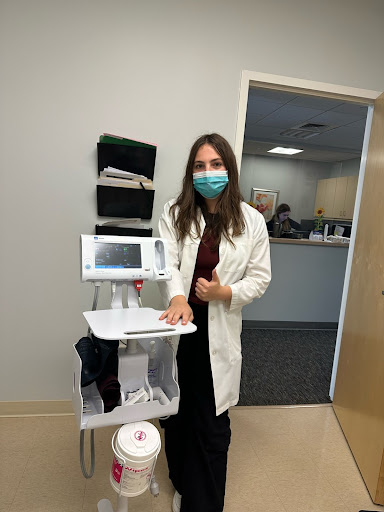Becca Samuels ’24 and Camille DeStefano ’24: Beth Israel Lahey in Wayland, MA
- The Rivers School
- Jul 28, 2023
- 5 min read

This summer, we had the opportunity to work with Dr. Deborah Riester at Beth Israel Lahey in Wayland, MA. Dr. Riester specializes in Internal Medicine and Endocrinology and many of her patients have diabetes. We were fortunate enough to be able to observe her in action (with patient permission) during some appointments, where we saw her techniques for diagnosing patients and helping them manage their diagnosis. Additionally, we researched various medical diseases that patients had so we could learn more about them.
During our time at Beth Israel, we worked with not only Dr. Riester, but her team as well (Lee Ann, Lindsey, Christina, and Will). We learned how to measure blood pressure using both the manual blood pressure cuff and the electronic blood pressure monitor typically used on patients. We also learned how to check for thyroid nodules or goiter and tested our new skills on each other. In addition, Dr. Riester introduced us to the topic of bone density. She regularly orders bone density tests for her patients to see if they have conditions such as osteoporosis (decreased bone mass). A bone density test uses X-rays to measure how many grams of calcium and other minerals are in a segment of bone. Within the test, there are T and Z scores. T-scores compare bone density with that of a young and healthy young adult, whereas Z-scores compare the average bone density of people of the same age and sex.
Dr. Riester’s team also administers other tests in their office such as EKGs and A1c tests. An A1c test is a small finger stick used to determine if someone has diabetes and to measure diabetes control. An A1c test result displays a person’s average blood sugar level, more specifically the percentage of hemoglobin proteins in the blood that are coated with sugars over the past two months. A high A1c (over 6.4%) indicates diabetes, while an A1c between 5.7% and 6.4% indicates pre-diabetes. Finally, an A1c under 5.7% indicates that a patient does not have diabetes. However, as bodies and habits change and a patient takes medication for diabetes, their target A1c can change.
We learned how complex life with diabetes can be and with that, we met with the marketing teams of the Freestyle Libre and Omnipod, two companies who strive to make life with diabetes easier to manage. A Freestyle Libre is a device no bigger than 2 quarters. It is a type of continuous glucose monitor (CGM) designed to give patients easy access to their glucose readings. This way of measuring glucose levels is more efficient and less painful than the traditional method involving finger pricking. For a patient to see their glucose level, all they need to do is scan the sensor with their phone. Omnipod is a device that provides insulin to patients through a pump. Since Omnipod is tubeless and waterproof, it can be worn virtually anywhere. The Omnipod can be tracked through an app on a lookalike phone device, so there is access to glucose levels constantly with it.
During our time with Dr. Riester, we also completed a project relating to motivational interviewing. Motivational interviewing is an approach to counseling that is used to encourage patients to reach their goals. We focused on patients with diabetes in this study because diabetes affects everyone differently. Although many people with diabetes have different experiences, most people share the common goal of finding ways to manage their blood sugar levels. Many people are not able to achieve goals that are set for them, so we thought it would be helpful to see how patients felt after setting their own goals. We did this through the process of motivational interviewing. To compare results, we asked Dr. Riester to practice conventional interviewing on around half of the patients and motivational interviewing on the other half. This will allow us to compare the success rates of both interviewing types when we check back in with the patients in a couple of weeks. We came up with three questions to ask patients that were conventional interviewing questions and three questions that were motivational interviewing questions.
Dr. Riester asked her diabetic patients either our conventional questions or our motivational questions. The motivational questions were more open ended and focused on having the patient set their own goals whereas the conventional interviewing was straight to the point. The patients who were asked the motivational questions generally had specific goals of lowering their A1c, finding a happy balance of food groups, and doing exercise that they enjoy. Our group of patients consisted of both male and female patients with an age range of 49 to 75 years old. We expected to see that the “motivational interviewing patients” would yield better results, as the patients set their own goals and therefore might have been more inclined to follow through with them.
After following up with the patients, we found that three out of the five patients who participated in the motivational interviewing group met their goals. One of the motivational patients did not meet any of their goals, and the other met around half of their goals. For the conventionally-interviewed patients, we found that one of the four patients met their goals, two of the four met some of their goals, and one patient did not meet any of their goals.
Conclusions:
Patients who were in the motivational interviewing group got to choose their own goals, so they were able to make sure the goals were reasonable enough for them.
Patients interviewed conventionally met some of their goals but not all of them and we think this is because it was “doctor’s orders” so they had an authority figure telling. them what they need to do, but because they did not come up with their goals, the people in that group were less likely and less motivated to actually complete them
People are more likely to commit to a goal if they create it themselves and that stays true to our results.
We had an outlier because one of our conventional participants is a new diabetic and he wanted to get control and learn about his diabetes, so he was highly self-motivated. Therefore, he was most likely capable of achieving lifestyle goals (conventional or motivational) regardless of the instructions.
If we were to do this study again, we think it would be ideal to have a larger testing group (with more diseases other than diabetes) divided into categories such as gender, age, and level of motivation from the start. Since there were only nine total patients in our study, the data is not extremely accurate, especially since there are many contributing factors that we were not able to note beforehand. However, even in this small group, we were able to see that on average, motivational interviewing does help a patient meet more of their goals than conventional interviewing.
Lastly, we would like to extend our gratitude to Dr. Riester and her team, the patients, and Mr. Schlenker for making this internship possible. We enjoyed learning more about the medical field, and could not have asked for a better experience. We appreciate all of your help and are incredibly grateful for this experience.













![Conventional Interviewing: Can you increase your exercise? Can you adjust your eating habits to include more fruits and vegetables? It is recommended for people with diabetes to avoid [BLANK]. Can you try that?](https://static.wixstatic.com/media/016515_a77f353293b54419bdd5d652ad20e150~mv2.png/v1/fill/w_420,h_250,al_c,blur_30/016515_a77f353293b54419bdd5d652ad20e150~mv2.png)
![Conventional Interviewing: Can you increase your exercise? Can you adjust your eating habits to include more fruits and vegetables? It is recommended for people with diabetes to avoid [BLANK]. Can you try that?](https://static.wixstatic.com/media/016515_a77f353293b54419bdd5d652ad20e150~mv2.png/v1/fill/w_460,h_274,al_c/016515_a77f353293b54419bdd5d652ad20e150~mv2.png)


Comments